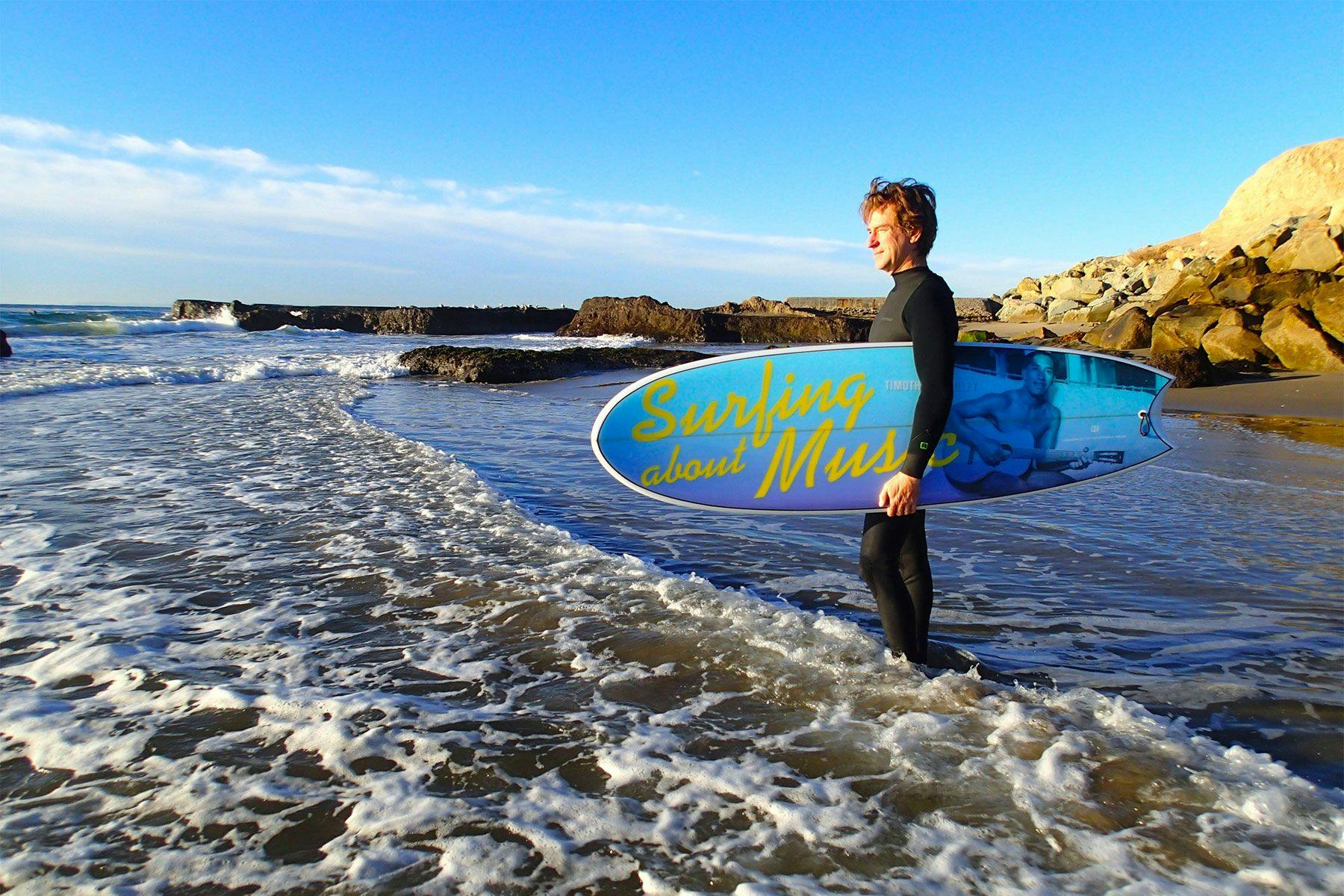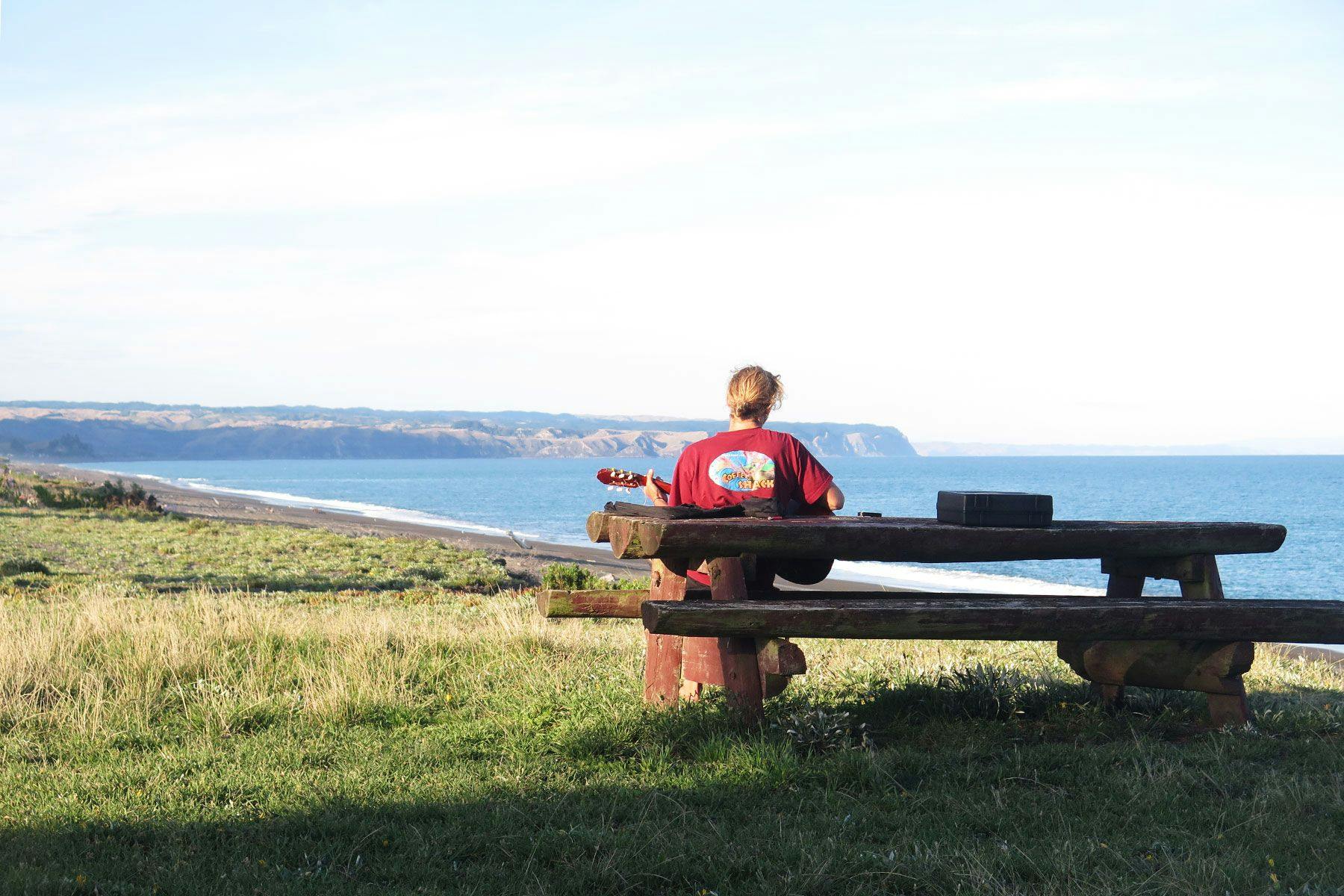Interviews, MusicSurfing About Music

The Timothy Cooley Interview
Sounds – just as images, tastes, textures, and smells – interweave the yarn of our individual experiences, ultimately fine tuning the cultural tapestry upon which our societies are built. As a structured derivative of these auditory effects, music exudes a fraction of who we are through the externalization of that which is intrinsic, diffusing wavelengths across time, space, and peoples.
Likewise, in the context surfing, the making of and/or listening to music happens as a personal, ever-present, ever-changing component of a surfer’s water-borne experience which, in turn, contributes to the development of this particular subculture. From the tunes one listens to before a session, to quintessential surf film soundtracks – there are various tangible similarities in the way music and surfing relate to each other. But beyond that which can be cross-referenced throughout history, classified in genres or explained by physics, there are also mutual sensory elements to both practices which all of us feel, some muse about, but few can articulate.

Timothy Cooley, a Professor of Ethnomusicology and Global and International Studies at UC Santa Barbara, is someone who has been thoroughly exploring this subtle yet powerful nexus between board-riding and music-making, not only through his personal journey as a surfer and musician but also in his work as an ethnomusicologist. His book, Surfing About Music, released back in 2014, pioneered a deeper and more academic look into the way surfing and music intertwine and influence each other, teasing us to consider just how much The Beatles might have influenced our bottom turn.
Before we dive into your work, it would be interesting to hear more about your personal relationship with surfing.
I was born in 1962 in Norfolk, Virginia, literally a block from the border with the town of Virginia Beach, where I learned how to bodysurf and generally became comfortable in the ocean. My older brother, David, was the first to get into surfing. This was the late 1960s when shortboards were the new thing. I have clear memories of him cutting a huge board down to something under 6 feet, square tail and pointy nose. He sort of rounded off the edges, cut a basic fin out of plywood, and glassed it up – purple. It was ugly, had pretty square rails, and was FLAT. Eventually, I ended up with that board and that is what I learned to surf on – in Florida.

And your relationship with music?
My dad was a Presbyterian minister, so I was in the church just about every time the doors were open. There, singing was normal and I sang in the kids choir and so forth. I recall my dad having a strong voice; he would lead the singing from the pulpit. Mom played piano and taught kids piano at our home – other people’s kids, none of her own! (I took piano lessons of my own accord later, from someone else). Still, there was a lot of singing and music-making going on in the church and in our home, so even as a kid, I knew I wanted to make music.
How did the two begin to intersect in a more concrete, mature way?
When I was 12, we moved to Pensacola, Florida, where I learned to stand-up surf on the aforementioned hand-me-down board. My dad’s new church had a huge youth-group that met Friday evenings, and there was a lot of guitar playing and singing. The group also had a bunch of surfers in it, so I would bum rides to the beach with them. When I was 15, my parents moved us back up to Virginia; not only back to Virginia, but inland, away from the beach. The upside was that the high school I went to was huge and it had an actual music department, where I buried myself. We were also near Washington DC, which had a great music scene. By my senior year, I was at the Kennedy Center for all sorts of concerts just about every week. I left there a well-trained musician.
When doing a masters in Music History at Northwestern University, in Evanston, Illinois, I would surf on Lake Michigan using that same board I had made in Florida when I was 15. Then, I moved back to the east coast in 1991 and went to Brown University for a PhD in ethnomusicology. Fast-forward a few years, I got my first full-time academic job at the University of California Santa Barbara, back in 1998. Realising that two sides of the campus were on the ocean, I drove to the closest surf shop, bought a wetsuit, went straight to campus point and caught the first wave I paddled for on that old 1970 surfboard. Then, about 20 years later, I find myself living in Southern California: an adult riding my adolescent board on the waves of my adolescent fantasies.
From a personal point of view, what are some ways (both practical and intangible) in which surfing and music intersect and relate to each other?
Practically, surfing and musicking are related to me autobiographically. In my formative years, I began identifying as a surfer and as a musician. This never changed even when I only rarely surfed. At the risk of being redundant, surfing was in my bones similar to the way that music was. The feeling of moving into the water and standing on the board is somehow formative for me. Skiing and rowing provided new ways of enjoying water – both liquid and frozen – but that never replaced the flow of surfing.
Similarly, musicking is another way of moving through time and space. Music plays with the experience of time just like sliding on the surfboard plays with movement. Both are things that shape how you think and feel. Riding a wave fills one senses; ideally, it makes one fully present in the moment and provides that feeling of flow that psychologist Mihaly Czikszentmihalyi has analyzed so well. The mental and physical focus required to make music produces a similar state of flow to surfing. Music too gets in your bones and takes over your mind.
Music has been a part of surf culture since its inception in Hawaii, however, a lot has changed both in the world of music and surfing since then. What would you say are the main differences between the way modern surfers and pre-20th century surfers relate to music?
It’s important to note that dramatic changes in Hawaiian culture had been happening since the end of the 18th century until the mid-20th century. I mention this because human relationships to music also change dramatically in the same way. What I’m referring to is the invention of recording and playback technology for sound. In the 1880s, sound recording and playback technology was viable; in the first decades of the 20th century that changed the way many societies experienced music. For the first time in human history people could listen to music without a musician actually in the room!
Gaston Georis, one of the members of the band The Sandals, who created the soundtrack for Bruce Brown’s film Endless Summer, told me that the transistor radio changed surfing in the mid-20th century by allowing people to listen to the radio lying on their towel on the beach for the first time in history. This coincides with general tendencies towards specialization in western culture. My point is that in Hawaii, as well as elsewhere, people’s relationship to music was changing especially from the end of the 19th to the early 20th century. Like so many other aspects of human cultural practices, music was being subtly separated from integration with other aspects of culture.
Back to what I think is the point of the question, in pre-20th century Hawaii, musical practices were more integrated with other cover practices such as surfing. As Hawaiian chants show us, a surfer of status would have his own surfing chant – surfing and music literally went together. But so did surfing and religion; surfing and ritual; surfing and dance (hula or visual poetry) and so forth. It is still the same today to great extent, but in my conception we tend to departmentalize these activities.
Yet, my research showed that many surfers are resistant to this separation. For at least a good number of the surfing musicians I interviewed, the ability to make music on or near the beach was an important part of their surfing life. Perhaps the greatest difference is that we have more music available at any one moment in any single place than in the 19th century. This makes it much more difficult now to say that X or Y music genre is surf music. As I pointed out in Surfing about Music, the genre of music named “surf music” in 1961 became a bit of a problem for surfers just a few years later. It became a stereotype that, especially in late 60s and early 70s, surfers needed to push against. But at its core, if we take a broad view of human musicking, much is still the same. Music helps surfers work out in their mind what surfing is, what surfing means.
You interviewed a wide array of surfers, musicians, and advocates when researching for your book. Was there a particular interview that stood out?
Yes, though this stand-out moment came more in casual conversation with Samuel Bonanno, the proprietor of a ukulele shop on Kaua‘i and the president of the Kamoa Ukulele Company (he makes very fine instruments, by the way). He was behind the counter in his shop Kapa‘a, and we got into a conversation about my project. He said “Music and surfing are the same thing…sound and music are both just waves.” Things just started to tumble into place after that as I kept hearing variations of the same idea from other surfers.
And Samuel is right on very profound levels: sound waves and ocean waves adhere to the same laws of physics. The same is true of light waves. Now, some 10 years later, I’m still working out the implications of this profound idea. I’ve tapped into this in a multi-authored book called Cultural Sustainabilities that is due out any day now. One of the themes is how sound vibrations unite all beings – human and otherwise.

During your research, have you found any particular sounds/instruments/bands that seemed ubiquitous among surfers?
The most ubiquitous instrument among surfers is the guitar, but this is not particularly unique to surfers. Among Hawaiian and “white” surfers, reggae is probably the single most common sound. When I was doing my research, from about 2001 to 2013, Jack Johnson and Donavon Frankenreiter were all over the airwaves in the US and much of Europe. In my opinion, Jack Johnson did a lot to break the fifty-year assumption that “surf music” meant surf guitar from Beach Boys-like songs about surfing. He freed surfing musicians from that stereotype and the surfing and music scene became a lot more interesting and nuanced after 2001.
Did you come across any ways in which “surf music” – or rather music made by surfers – has seeped through to other genres and non-sportive subcultures?
Absolutely. For example, whereas 15 years ago students on my campus, the University of California Santa Barbara, generally knew that Jack Johnson was a surfer and many of them would’ve connected his music with surfing, now not that many do. Just a few weeks ago I asked my class 30+ undergraduates if they knew who Jack Johnson was and what sort of music they associated him with. (Jack Johnson is an alum of the University of California Santa Barbara, by the way). A little more than half of the students knew who Jack Johnson was, but many of them knew his music through the Curious George film! His ultra laid-back songs became an anthem for a generation of young people well beyond surfers.
How do you see surf culture – and surfing as a practice – being affected by this new, more digitized musical era?
Very interesting. I documented the shift of the center of the surfing industry from Hawaii to Southern California in the 20th century in my book. One of the many things that came with that was a reinvention of what surfing means in some ways, and that meaning included the idea of surfing as a lifestyle that helped sell, well, mostly clothing. I have found “surf shops” in various cities around the world selling all sorts of clothes, but no surfboards, for example. Of course, clothing, like music, is one of the ways that we project who we are and who we would like to be.
While the new digitized exchange of images and sounds instantly around the world offers greater potential for diversity of ideas, it also enables certain ideas (including musical sounds and surfing images) to get greater exposure. We all see the same images of surfing – the same clips of the champion surfer doing an air or something. Or more influential in society at large is the image of a surfer on a huge wave. Surfing style gets compressed a bit by this focus. Non-surfers think that is what surfing is about, but most of us are very happy with a clean 6-foot wave.
My point is, surfing is more common around the world than it was 20 years ago, but surfing is also more similar around the world too. There are many counter examples to this too, and those are important. I surfed a fair amount in the UK, where surfing is growing faster than some more traditional sports (the UK is an island, after all!). I lived in the south of England and surfed in the English channel as well as down in Cornwall. Especially in the channel, the seasoned surfers preferred boards that were subtly but significantly different from what is preferred here in Southern California. Same with music. Obviously there are trends that spread across the world rapidly, but local variation is where soul is.
In your opinion, are there ways in which someone can enrich their surf experience with music?
Competitive athletes in many sports use music to amp-up for competition and to calm themselves down afterwards. Surfers are no exception. Yet surfers who are not particularly competitive but into it as a lifestyle seem to use music differently. Making music and/or listening to music becomes a way to expand and even explain the feeling of surfing. I think Hawaiians were really good at this, and still are. I think it’s best to not be too obsessed with how good you are surfing or with what type of music or your ability to make music is. Just make some sounds, make some music. It will improve your quality of life and maybe your surfing a bit too.
You can find out more about Timothy’s book Surfing About Music by clicking here.